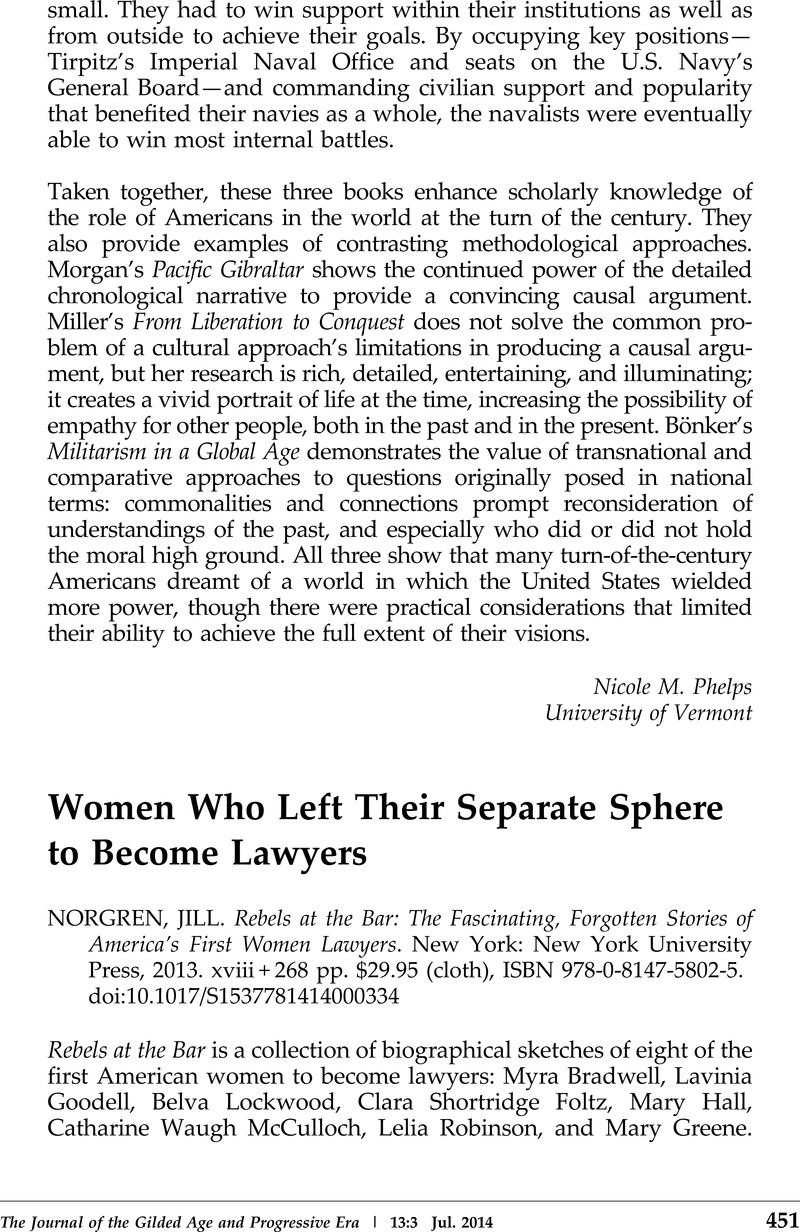No CrossRef data available.
Article contents
Women Who Left Their Separate Sphere to Become Lawyers - Jill Norgren. Rebels at the Bar: The Fascinating, Forgotten Stories of America's First Women Lawyers. New York: New York University Press, 2013. xviii + 268 pp. $29.95 (cloth), ISBN 978-0-8147-5802-5.
Published online by Cambridge University Press: 15 July 2014
Abstract

- Type
- Book Reviews
- Information
- Copyright
- Copyright © Society for Historians of the Gilded Age and Progressive Era 2014
References
1 Norgren says that Charlotte E. Ray, an African American graduate of Howard Law School and the first woman admitted to the District of Columbia bar, “belongs in this story of ‘rebels.’” But Ray practiced only briefly and quit the law.
2 Bradwell v. Illinois, 83 U.S. (16 Wall.) 130, 141 (1873) (Bradley, J., concurring).
3 Susan Gluck Mezey, “Bradwell, Myra Colby,” American National Biography Online, www.anb.org/articles/11/11-00095.html.
4 Norgren, 65–66, quoting In re Goodell, 39 Wisc. 232, 239–40 (1875) (Chief Justice Edward G. Ryan).
5 A collection of the letters has been published: Drachman, Virginia G., ed., Women Lawyers and the Origins of Professional Identity in America: The Letters of the Equity Club, 1887 to 1890 (Ann Arbor, 1993)Google Scholar.
6 Full-length biographies have been published for three of the women Norgren profiles: Babcock, Barbara Ann, Woman Lawyer: The Trials of Clara Foltz (Stanford, 2011)Google Scholar; Friedman, Jane M., America's First Woman Lawyer: The Biography of Myra Bradwell (Buffalo, 1993)Google Scholar; Norgren, Jill, Belva Lockwood: The Woman Who Would Be President (New York, 2007)Google Scholar. Works portraying many early women lawyers include Drachman, Virginia G., Sisters in Law: Women Lawyers in Modern American History (Cambridge, MA, 1998)Google Scholar; Morello, Karen Berger, The Invisible Bar: The Woman Lawyer in America, 1638 to the Present (New York, 1986)Google Scholar; Mossman, Mary Jane, The First Women Lawyers: A Comparative Study of Gender, Law and the Legal Professions (Oxford, 2006)Google Scholar (includes United States, Canada, Britain, New Zealand, British India, Europe). Norgren acknowledges Stanford Law School's website, the Women's Legal History Project, http://wlh.stanford.edu.
7 Norgren recounts Belle Mansfield, who was admitted to the Iowa bar in 1869; and Alta Hulett, admitted to the Illinois bar in 1873, among others.
8 In 1880, fewer than 100 American women were lawyers (p. 201); in 1890, 208 (p. 177); and in 1900, 1,000 (compared with 10,000 men) (p. 205).


